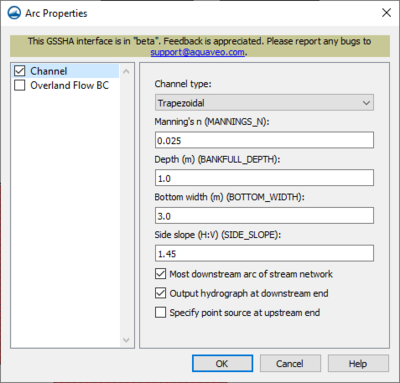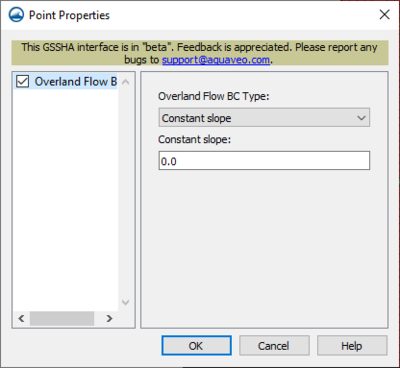User:Jcreer/SMS:GSSHA Coverages: Difference between revisions
From XMS Wiki
Jump to navigationJump to search
| Line 54: | Line 54: | ||
***"Constant stage (water surface elevation)" – | ***"Constant stage (water surface elevation)" – | ||
****''Constant stage (water surface elevation):'' – Enter decimal value here | ****''Constant stage (water surface elevation):'' – Enter decimal value here | ||
***"Variable stage (water surface elevation)" – Define a WSE curve | ***"Variable stage (water surface elevation)" – Define a WSE curve through a point | ||
****''Variable stage (water surface elevation)'' – | ****''Variable stage (water surface elevation)'' – Click below to input or import parameters for WSE. | ||
*****'''Edit XY Series...''' to bring up the ''[[SMS:XY Series Editor| XY Series Editor]]'' dialog. | *****'''Edit XY Series...''' to bring up the ''[[SMS:XY Series Editor| XY Series Editor]]'' dialog. | ||
***"Variable flow (cms discharge)" – Define a discharge curve in cubic meters per second. | ***"Variable flow (cms discharge)" – Define a discharge curve in cubic meters per second through a point. | ||
****''Variable flow (cms discharge):'' – | ****''Variable flow (cms discharge):'' – Click below to input or import parameters for cms discharge. | ||
*****'''Edit XY Series...''' to bring up the ''[[SMS:XY Series Editor| XY Series Editor]]'' dialog. | *****'''Edit XY Series...''' to bring up the ''[[SMS:XY Series Editor| XY Series Editor]]'' dialog. | ||
***"Variable flow (cfs discharge)" – Define a discharge curve in cubic feet per second. | ***"Variable flow (cfs discharge)" – Define a discharge curve in cubic feet per second through a point. | ||
****''Variable flow (cfs discharge):'' – | ****''Variable flow (cfs discharge):'' – Click below to input or import parameters for cfs discharge. | ||
*****'''Edit XY Series...''' to bring up the ''[[SMS:XY Series Editor| XY Series Editor]]'' dialog. | *****'''Edit XY Series...''' to bring up the ''[[SMS:XY Series Editor| XY Series Editor]]'' dialog. | ||
Revision as of 16:22, 23 May 2024
| This contains information about functionality available starting at SMS version 13.4. The content may not apply to other versions. |
The GSSHA model makes use of the simulation based modeling approach. This requires defining coverages in the Map module to build the components for use in the GSSHA simulation.
A GSSHA simulation makes use of the following coverage types:
- Boundary Conditions
Boundary Conditions Coverage
SMS GSSHA creates boundary conditions to feature arcs and feature points (but NOT to nodes).
Arc Properties
To assign properties to arcs for boundary conditions, select an arc, then double click on it.
- Channel – User defines the channel properties here.
- Channel type – User chooses which channel type here.
- Trapezoidal – Trapezoidal channels are used to define channel routing in GSSHA models. SMS automatically assigns a link number to trapezoidal channel arcs.
- Manning's n (MANNINGS_N): – Manning's n roughness coefficient. Appears under both Channel options. Enter the Manning's n integer here.
- Depth (m) (BANKFULL_DEPTH): – The maximum depth of the channel represented by the GSSHA feature arc in meters.
- Bottom width (m) (BOTTOM_WIDTH): – The width of the bottom of the channel in meters.
- Side slope (H:V) (SIDE_SLOPE): – The horizontal value to one unit of vertical rise.
- Cross-section – The profile of irregular cross sections are defined using XY coordinate pairs.
- Manning's n (MANNINGS_N): – Manning's n roughness coefficient. Appears under both Channel options. Enter the Manning's N integer here.
- Cross section:
- Edit XY Series – Selecting this bring up the XY Series Editor dialog.
- Trapezoidal – Trapezoidal channels are used to define channel routing in GSSHA models. SMS automatically assigns a link number to trapezoidal channel arcs.
- Most downstream arc of stream network – Turning this on assigns one arc as the most downstream and directs all flow from other arcs towards the selected arc.
- Output hydrograph at downstream end – Turning this on will allow creation of a hydrograph at the downstream end.
- Specify point source at upstream end – Turning this on will specify one
- Channel type – User chooses which channel type here.
- Overland Flow BC – Set the overland flow boundary conditions for an arc.
- Overland Flow BC Type: – A drop-down list with the following options:
- "Constant slope" –
- Constant slope: – Enter decimal value here
- "Constant stage (water surface elevation)" –
- Constant stage (water surface elevation): – Enter decimal value here
- "Variable stage (water surface elevation)" – Define a WSE curve
- Variable stage (water surface elevation) – To set the parameters of a WSE
- Edit XY Series... to bring up the XY Series Editor dialog.
- Variable stage (water surface elevation) – To set the parameters of a WSE
- "Variable flow (cms discharge)" – Define a discharge curve in cubic meters per second.
- Variable flow (cms discharge): –
- Edit XY Series... to bring up the XY Series Editor dialog.
- Variable flow (cms discharge): –
- "Variable flow (cfs discharge)" – Define a discharge curve in cubic feet per second.
- Variable flow (cfs discharge): –
- Edit XY Series... to bring up the XY Series Editor dialog.
- Variable flow (cfs discharge): –
- "Constant slope" –
- Overland Flow BC Type: – A drop-down list with the following options:
Point Properties
To assign boundary conditions to a point, select a point (NOT a node), then double click on it.
Properties set here apply only to points, not nodes.
- Overland Flow BC – Set the overland flow boundary conditions for an arc.
- Overland Flow BC Type: – A drop-down list with the following options:
- "Constant slope" –
- Constant slope: – Enter decimal value here
- "Constant stage (water surface elevation)" –
- Constant stage (water surface elevation): – Enter decimal value here
- "Variable stage (water surface elevation)" – Define a WSE curve through a point
- Variable stage (water surface elevation) – Click below to input or import parameters for WSE.
- Edit XY Series... to bring up the XY Series Editor dialog.
- Variable stage (water surface elevation) – Click below to input or import parameters for WSE.
- "Variable flow (cms discharge)" – Define a discharge curve in cubic meters per second through a point.
- Variable flow (cms discharge): – Click below to input or import parameters for cms discharge.
- Edit XY Series... to bring up the XY Series Editor dialog.
- Variable flow (cms discharge): – Click below to input or import parameters for cms discharge.
- "Variable flow (cfs discharge)" – Define a discharge curve in cubic feet per second through a point.
- Variable flow (cfs discharge): – Click below to input or import parameters for cfs discharge.
- Edit XY Series... to bring up the XY Series Editor dialog.
- Variable flow (cfs discharge): – Click below to input or import parameters for cfs discharge.
- "Constant slope" –
- Overland Flow BC Type: – A drop-down list with the following options:
SMS – Surface-water Modeling System | ||
|---|---|---|
| Modules: | 1D Grid • Cartesian Grid • Curvilinear Grid • GIS • Map • Mesh • Particle • Quadtree • Raster • Scatter • UGrid |  |
| General Models: | 3D Structure • FVCOM • Generic • PTM | |
| Coastal Models: | ADCIRC • BOUSS-2D • CGWAVE • CMS-Flow • CMS-Wave • GenCade • STWAVE • WAM | |
| Riverine/Estuarine Models: | AdH • HEC-RAS • HYDRO AS-2D • RMA2 • RMA4 • SRH-2D • TUFLOW • TUFLOW FV | |
| Aquaveo • SMS Tutorials • SMS Workflows | ||

